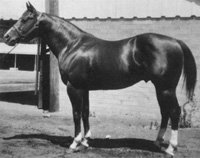
Not that long ago, I vowed I would never write another book. Now here I am, deep into a history of the National Cutting Horse Association Futurity.
The appeal of this project is not just putting 50 years of cutting horses and cutting competition into perspective – the 50th NCHA Futurity will be held this year -Â but in delving into decades of my interviews, research and records and finding interesting bits of information that, if ever previously noted, have long been forgotten.
Doc’s Yuba Lea, the 1974 NCHA Futurity champion, for instance, was out of a daughter of Leo that sold for $5,700, at the 1964 California Mid-Winter Race Sale in Pomona. The sale topper at $40,000 was the stallion Mr. Bruce, by Three Bars.
My Dinah Lea, in foal to Rocket Bar (TB), was purchased by Mrs. Stephen Jensen. Jensen and her husband owned the Quarter race-bred stallion Doc Bar, who was by Lightning Bar by Three Bars.
The Jensens had purchased 6-year-old Doc Bar in 1962 to promote as a halter horse sire. But My Dinah Lea helped usher in a new direction for Doc Bar and a new era for the cutting world.
Following the birth of the Rocket Bar filly, Little Laser in 1965, the Jensens bred My Dinah Lea to Doc Bar. The next year, they got a sorrel colt that they named Doc’s Leo Lad.
In 1969, riding for Len Perry, Carol Rose would show Doc’s Leo Lad to fourth place in the NCHA Futurity – the same year that Shorty Freeman claimed the Futurity reserve championship on Doc’s Kitty, and Buster Welch placed third place on Doc’s Luck Bar.
Doc’s Kitty, Doc’s Luck Bar and Doc’s Leo Lad were Doc Bar’s first offspring to place in the NCHA Futurity finals. Today, it would be impossible to find an NCHA Futurity champion or finalist without Doc Bar in their pedigree.
Of course, Doc’s Leo Lad was not My Dinah Lea’s last Futurity finalist, either. In addition to champion Doc’s Yuba Lea, she also produced 1972 finalist Doc’s Nanaimo, and 1973 finalist Doc’s Leopard.
Leon Harrel, who showed Doc’s Yuba Lea, as well as 1987 NCHA Futurity champion Smart Date, got his start on the Turnbow Ranch in Calif., working with Quarter race horses sired by the Three Bars son Barred. In 1968, Harrel began training cutting horses.
“I think the trainers could see, when the first three Doc Bar horses came to the Futurity in 1969, that they had exceptional style in the way they moved and the way they accepted that challenge from a cow,” said Harrel. “They were just so much more stylish moving than what we had on the scene at the time that people thought, boy, I’ve got to have one.”
My book, “Cutting Horse Gold: A 50-Year History of the NCHA Futurity,” will be published and available this fall.
